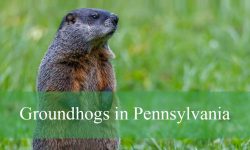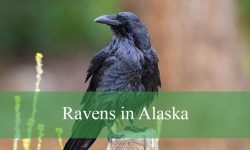California is a haven for bird enthusiasts, offering an incredible diversity of raptors across its landscapes. From soaring eagles in the Sierra Nevada to stealthy owls in coastal forests, the state provides countless opportunities to observe these powerful hunters in the wild. Each bird of prey plays a vital role in maintaining balance within its ecosystem.
With its varied geography, California supports hawks, falcons, owls, eagles, and vultures in abundance. Open grasslands attract hunting hawks, while marshes and wetlands provide the perfect setting for osprey and harriers. Meanwhile, mountain ranges and forests offer ideal habitats for owls and goshawks. This diversity makes the Golden State one of the richest places in North America to study raptors.
This guide highlights 33 birds of prey found in California, complete with identification tips and insights into their behaviors. Birdwatchers, photographers, and nature lovers will find this resource useful for understanding the appearance, habitats, and habits of these remarkable species.
Types of Birds of Prey Found in California
Red-tailed Hawk
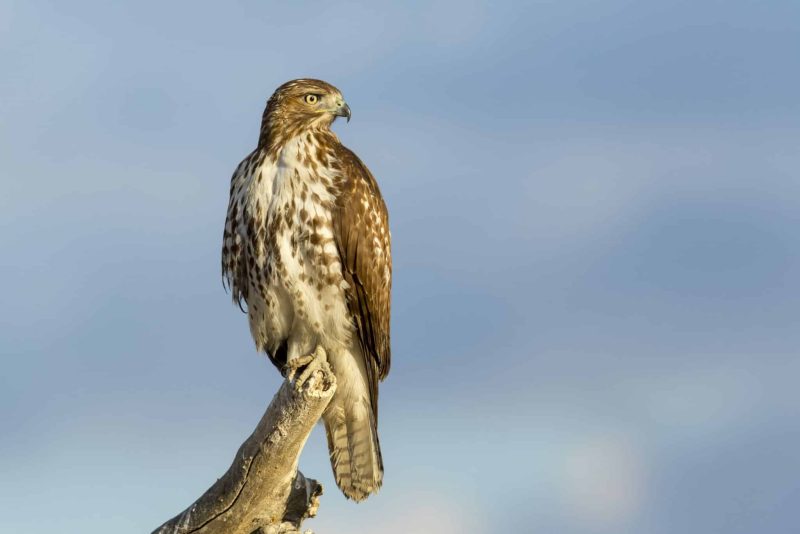
The Red-tailed Hawk is one of the most widespread and easily recognizable raptors in California. It is known for its broad, rounded wings and a characteristic reddish-brown tail, which is most visible in adults. The bird’s plumage varies, but the reddish tail and dark bar on the leading edge of the underwing are key identifiers.
This species is a versatile hunter, feeding on small mammals such as rabbits, squirrels, and rodents. They are also opportunistic, sometimes eating birds, reptiles, and insects when available. Red-tailed Hawks often perch on poles, trees, or fence posts to spot prey.
Red-tailed Hawks are highly adaptable and can thrive in a variety of habitats, including deserts, grasslands, forests, and urban areas. In California, they are commonly seen soaring along highways or nesting in large trees near open fields.
Breeding season usually occurs in late winter or early spring. They build large nests of sticks lined with softer materials. Both parents participate in raising the young, and the chicks fledge after about 6 weeks.
Cooper’s Hawk
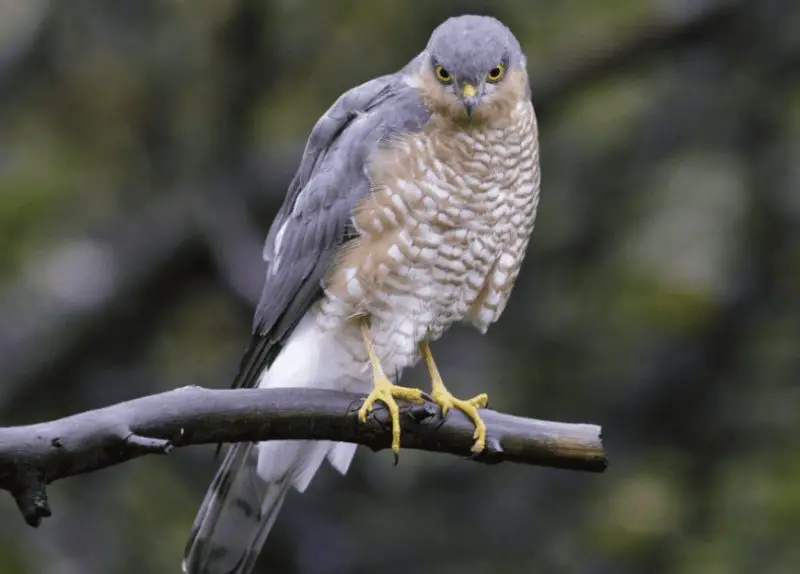
Cooper’s Hawks are medium-sized hawks with a slender body and long tail, adapted for maneuvering through forests and dense vegetation. Adults typically have a blue-gray back, reddish barring on the chest, and a rounded tail with dark bands. Juveniles are brown above with streaked underparts.
This species is a skilled predator of birds, particularly medium-sized songbirds, but also hunts small mammals. It relies on stealth and surprise, often gliding silently through trees to ambush prey.
Cooper’s Hawks prefer wooded areas and suburban neighborhoods with plenty of cover. They are less frequently seen soaring in open skies compared to Red-tailed Hawks, instead staying closer to the canopy.
During breeding, Cooper’s Hawks build stick nests high in trees, often reusing old nests. Clutch size ranges from 3 to 5 eggs, and both parents are involved in feeding and protecting the chicks until they fledge after about a month.
Sharp-shinned Hawk
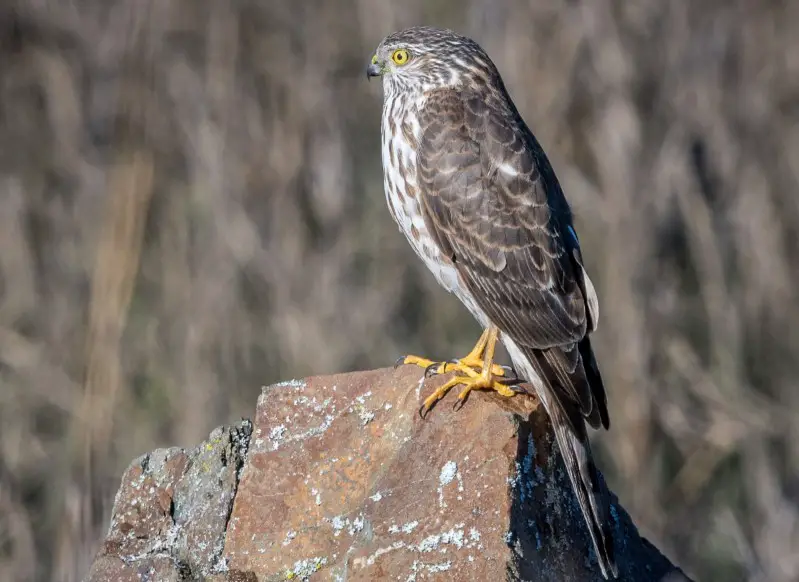
The Sharp-shinned Hawk is the smallest hawk found in California, distinguished by its short, rounded wings and long, squared tail. Adult males have blue-gray upperparts and reddish barring on the chest, while females are larger and slightly browner. Juveniles are brown with streaked underparts.
This hawk specializes in hunting small birds, often capturing them mid-flight. It uses rapid, agile flight to navigate dense trees and shrubs, making it a highly effective predator of backyard songbirds.
Sharp-shinned Hawks are typically found in forested areas and woodlands but can also appear in suburban settings, especially during migration. They are secretive and often stay hidden, making sightings less common.
Nesting occurs in coniferous or mixed forests. The female incubates the eggs while the male hunts. Chicks fledge around 3 to 4 weeks after hatching, gradually learning to hunt under parental supervision.
Northern Harrier
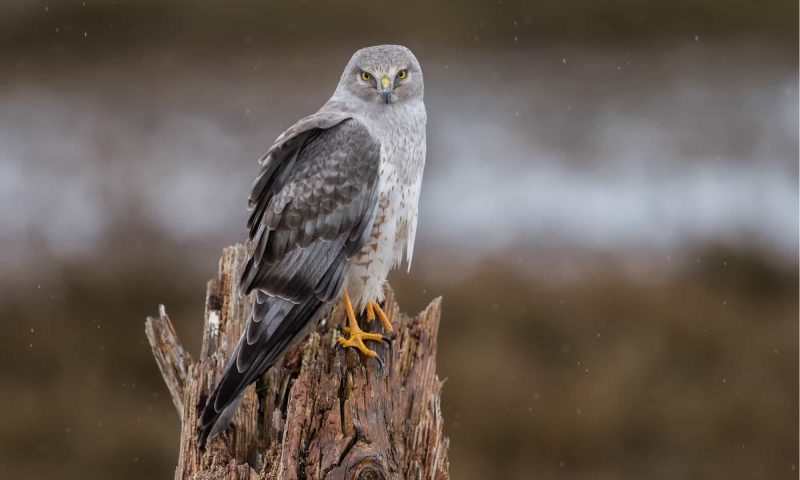
The Northern Harrier is a medium-sized raptor known for its low, gliding flight over open fields and marshes. Males are gray above with a white rump patch, while females and juveniles are brown with streaked underparts. Its owl-like facial disk helps amplify sound while hunting.
Northern Harriers primarily feed on small mammals and birds, using their keen hearing and vision to detect prey in tall grass. They often fly low and slow, quartering the ground to surprise targets.
In California, Northern Harriers inhabit grasslands, marshes, and agricultural fields. They are migratory, with populations increasing in open habitats during winter. These birds are also relatively tolerant of human activity compared to forest hawks.
Breeding pairs build nests on the ground, hidden in dense vegetation. Females lay 4–7 eggs, which hatch after about a month. Both parents feed the young, which fledge in roughly 5–6 weeks.
Ferruginous Hawk
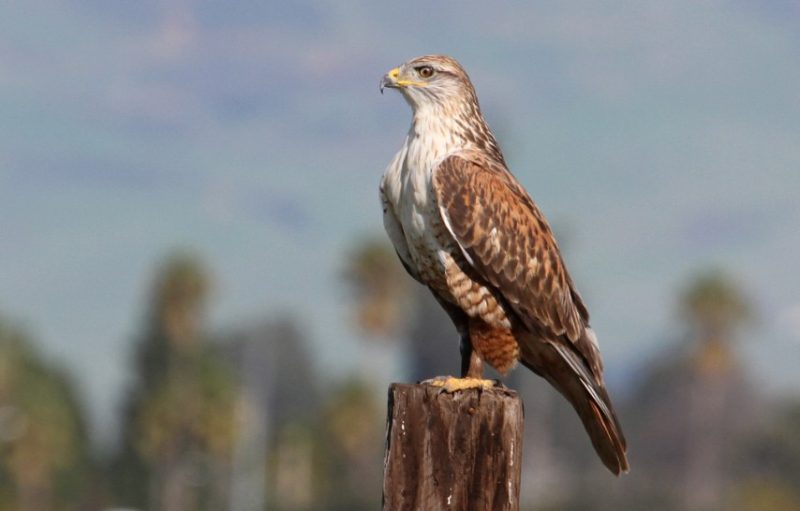
The Ferruginous Hawk is the largest hawk native to North America, with a broad wingspan and powerful build. Adults display pale underparts with rusty-colored legs and back, giving the species its name. Juveniles are more mottled brown but similarly large and robust.
Ferruginous Hawks hunt mammals such as rabbits, ground squirrels, and prairie dogs. They often perch on fence posts or soar at great heights to locate prey, using a combination of keen eyesight and strength to capture larger targets.
This species prefers open grasslands, deserts, and shrublands. In California, they are most commonly seen in the eastern and central parts of the state, where open terrain allows them to hunt efficiently.
During breeding, Ferruginous Hawks build large nests on cliffs, trees, or man-made structures. Clutch size ranges from 2 to 4 eggs, and both parents share in raising the young, which fledge after about 6 weeks.
Bald Eagle
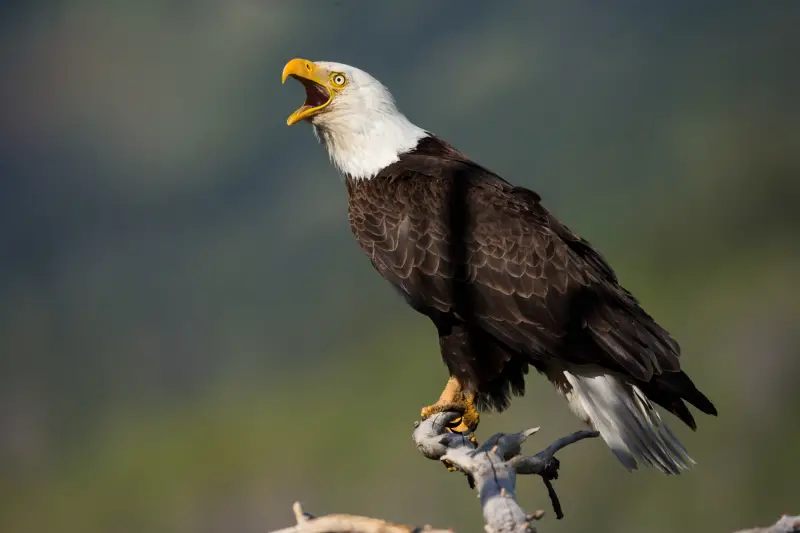
The Bald Eagle is one of the most iconic birds of prey in California and across North America. Adults are instantly recognizable by their white head and tail contrasting with a dark brown body and wings. Juveniles are mottled brown with variable white patches until they reach maturity at about five years of age.
Bald Eagles primarily feed on fish, which they catch with their strong talons, but they are also known to scavenge carrion and steal food from other birds. They are powerful flyers and can soar at great heights while scanning for prey.
In California, Bald Eagles are most commonly seen near large lakes, reservoirs, and coastal estuaries where fish are abundant. Populations have rebounded significantly due to conservation efforts and legal protection.
Breeding pairs build enormous stick nests, sometimes over eight feet wide, usually in tall trees near water. Females lay one to three eggs, and both parents share the responsibility of raising the young until they fledge at about 10 to 12 weeks.
Golden Eagle
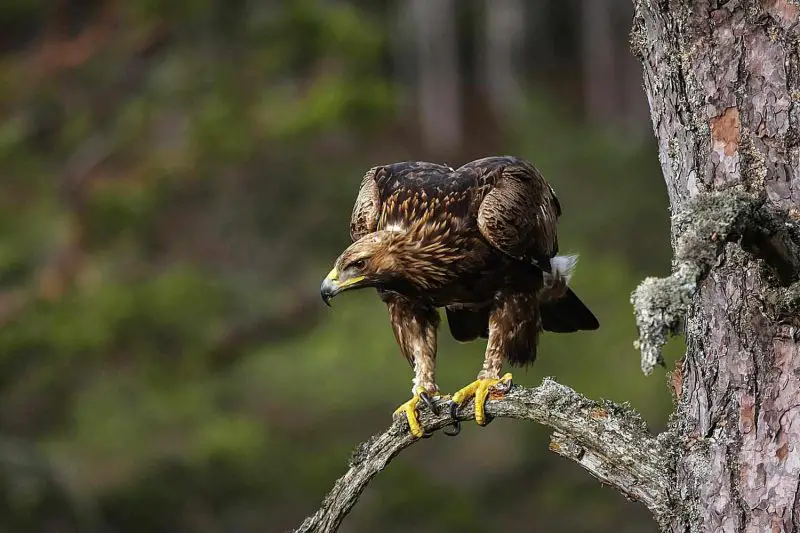
The Golden Eagle is one of the largest raptors in California, admired for its speed and strength. Adults have dark brown plumage with golden feathers on the back of the head and neck, while juveniles often display white patches on their wings and tail.
This eagle hunts mainly small to medium mammals such as jackrabbits, ground squirrels, and prairie dogs, but it is also capable of taking larger prey. Golden Eagles are powerful hunters, using both soaring flight and surprise attacks.
Golden Eagles inhabit a wide range of open landscapes, including grasslands, deserts, and mountainous areas of California. They avoid densely populated urban zones, preferring wild, open country.
Nests are usually built on cliffs or in large trees. The female lays one to three eggs, which hatch after about six weeks. Young eagles are dependent on their parents for several months before becoming independent.
White-tailed Eagle
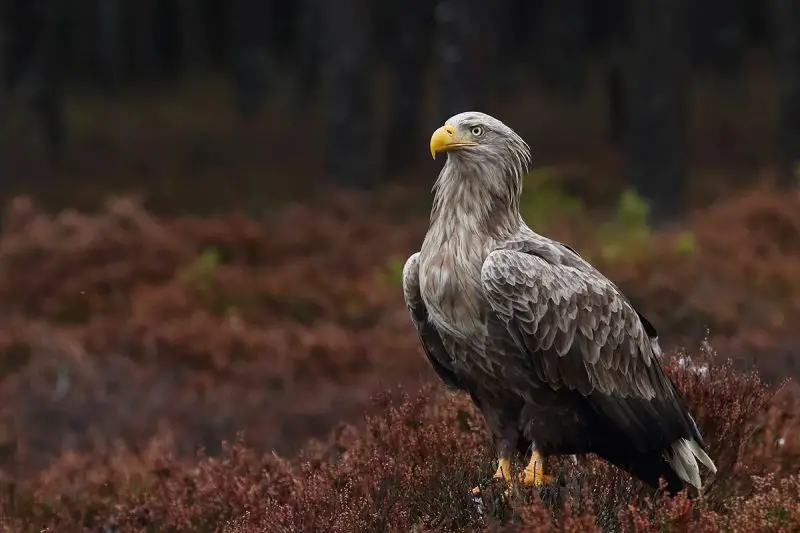
The White-tailed Eagle is a rare visitor to California, more commonly found in Europe and parts of Asia. It is a massive raptor with broad wings, a short wedge-shaped tail, and pale brown plumage. Adults have a distinctive white tail, which gives the species its name.
This eagle feeds mainly on fish and waterbirds, often scavenging along shorelines and wetlands. Its hunting style is similar to that of the Bald Eagle, using powerful talons to snatch prey from the water’s surface.
Although sightings in California are extremely uncommon, occasional reports of vagrants exist. Such records make it a notable species for birdwatchers hoping to spot something unusual.
In its native range, the White-tailed Eagle breeds near coasts, rivers, and large lakes. Large stick nests are built in trees or on cliffs, reused and expanded each year. In California, any observation of this eagle is considered a remarkable rarity.
Peregrine Falcon
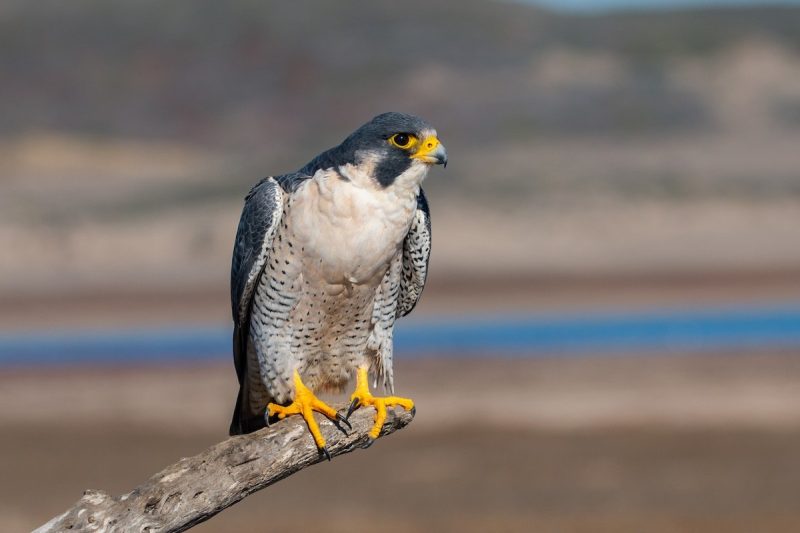
The Peregrine Falcon is famed as the fastest animal on earth, capable of diving at speeds over 200 miles per hour. Adults have a blue-gray back, barred underparts, and a black head with a distinct facial “mustache” mark.
Peregrine Falcons feed mainly on birds, from pigeons to waterfowl, which they strike mid-air with incredible precision. Their hunting style involves soaring high and then stooping in a dramatic dive to capture prey.
In California, Peregrine Falcons can be found along coastlines, cliffs, and increasingly in cities where they nest on tall buildings and hunt urban pigeons. Their recovery from near extinction due to pesticide use is a major conservation success story.
Nesting typically occurs on cliffs or man-made structures. Females lay three to four eggs, and both parents share incubation and feeding duties. Chicks grow rapidly and are skilled fliers within six weeks of hatching.
American Kestrel

The American Kestrel is the smallest falcon in North America, but it is bold and highly adaptable. Males are brightly marked with blue-gray wings, rusty backs, and spotted underparts, while females are more uniformly brown with streaking.
This falcon feeds on insects, small mammals, and occasionally small birds. It often hunts by hovering in mid-air before dropping down on prey, a behavior that makes it easy to recognize in the field.
American Kestrels inhabit a variety of environments in California, from farmlands and grasslands to deserts and suburban areas. They often perch on wires or fence posts to scan for prey.
Breeding takes place in cavities, including tree holes or nest boxes. Clutches usually contain four to five eggs, and both parents contribute to feeding the chicks, which fledge after about a month.
Merlin
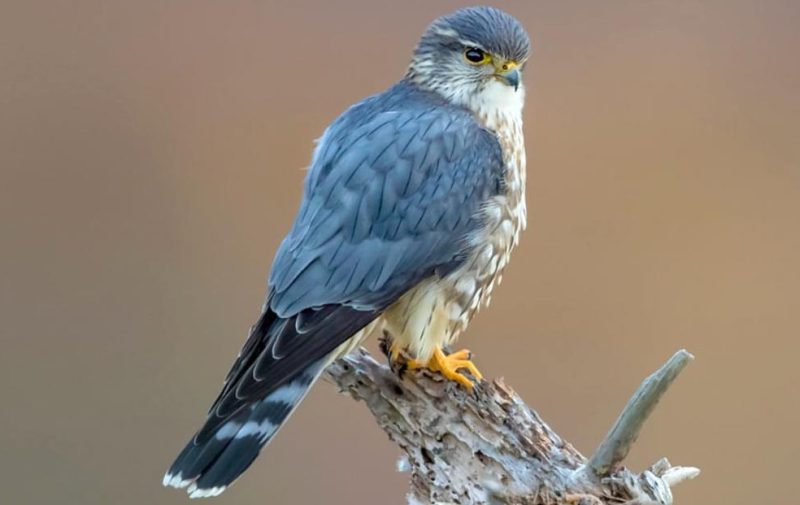
The Merlin is a small, fast-flying falcon found in California, known for its compact body, pointed wings, and fierce hunting style. Adults have slate-gray backs, streaked underparts, and a distinctive dark mustache mark, while juveniles are brown with streaked chests.
Merlins feed primarily on small birds, capturing them in rapid pursuit during flight. They are highly agile hunters, often seen darting through trees or open skies to ambush prey. Their hunting style relies on speed, surprise, and relentless energy.
In California, Merlins inhabit open woodlands, grasslands, and coastal areas. They are also migratory, with northern populations traveling to the state during winter months to hunt and breed. Merlins are relatively secretive, so spotting one can be challenging.
Nesting occurs in abandoned stick nests of other birds, often in conifers or on cliffs. Females lay 3–6 eggs, which hatch after about three weeks. Both parents feed and care for the chicks until they fledge at around four weeks.
Great Horned Owl
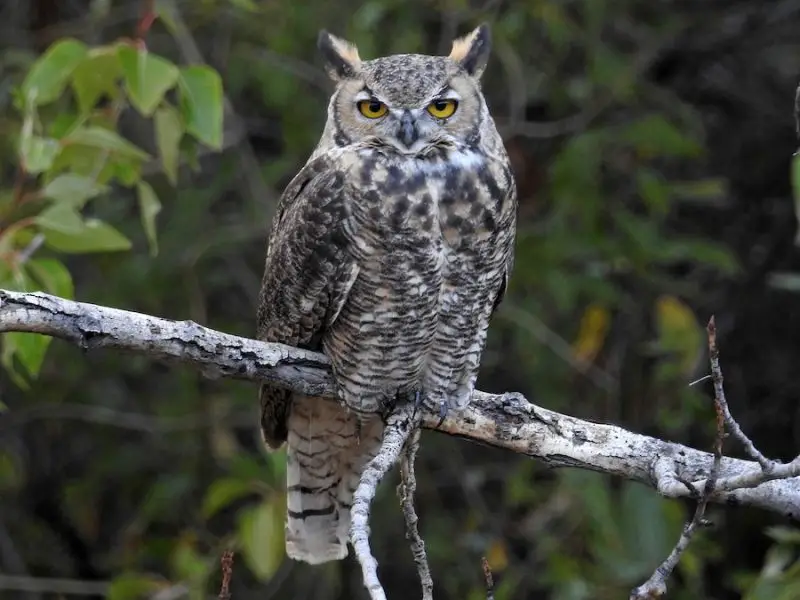
The Great Horned Owl is a large and powerful nocturnal raptor, easily recognized by its ear tufts, large yellow eyes, and mottled brown plumage. Juveniles have softer, fluffier feathers and a more uniform brown color.
This owl is an apex predator, feeding on mammals, birds, reptiles, and even other raptors. It hunts mainly at night, using silent flight and exceptional hearing to locate prey. Great Horned Owls are known for their adaptability and broad diet.
Great Horned Owls are found throughout California, from forests and deserts to urban parks and suburban areas. They require large trees or cliff ledges for nesting but are otherwise flexible in habitat choice.
Nesting occurs in abandoned nests of other birds, cliffs, or large trees. Clutch sizes range from 2–4 eggs, with incubation by the female for about a month. Chicks are fed by both parents and fledge approximately 6–7 weeks after hatching.
Barn Owl
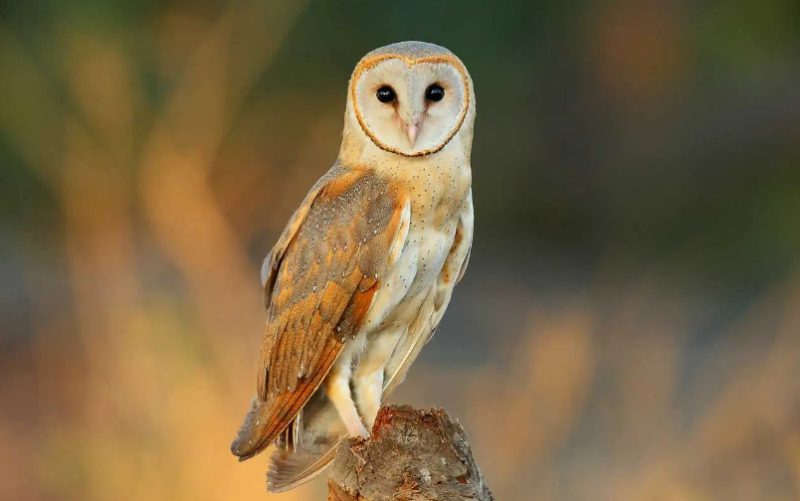
The Barn Owl is a medium-sized nocturnal raptor, recognizable by its heart-shaped facial disc, pale underparts, and golden-buff back. Juveniles are covered in soft, downy feathers and gradually develop the adult plumage.
Barn Owls primarily hunt small mammals, especially rodents, making them important for controlling pest populations. They hunt silently at night, gliding low over fields and grasslands to detect and capture prey with their sharp talons.
In California, Barn Owls are found in grasslands, agricultural fields, and open woodlands. They often roost in barns, old buildings, or tree cavities, which makes them familiar to farmers and rural residents.
Barn Owls nest in cavities, barns, or nest boxes. The female lays 4–7 eggs, which she incubates for about a month. Both parents feed the chicks until they are ready to fledge at around 8–10 weeks.
Western Screech-Owl
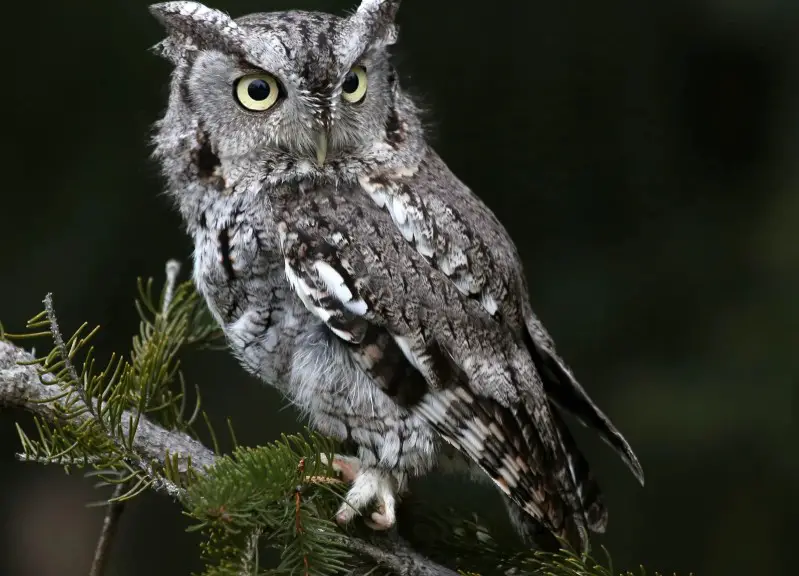
The Western Screech-Owl is a small, camouflaged owl with gray-brown plumage, streaked underparts, and small ear tufts. Its cryptic coloration helps it blend into tree bark and avoid predators. Juveniles resemble adults but are slightly fluffier and less defined in pattern.
This owl feeds on small mammals, insects, and occasionally small birds. It hunts mainly at night, using keen hearing and low-light vision to locate prey. Western Screech-Owls are known for their distinctive trilling calls.
Western Screech-Owls inhabit woodlands, suburban areas, and orchards across California. They are cavity nesters, often using tree holes, nest boxes, or abandoned buildings for shelter and breeding.
Breeding occurs in spring, with 3–5 eggs per clutch. Females incubate the eggs for about a month, while males provide food. Chicks fledge around 4–5 weeks, learning to hunt under parental guidance.
Burrowing Owl
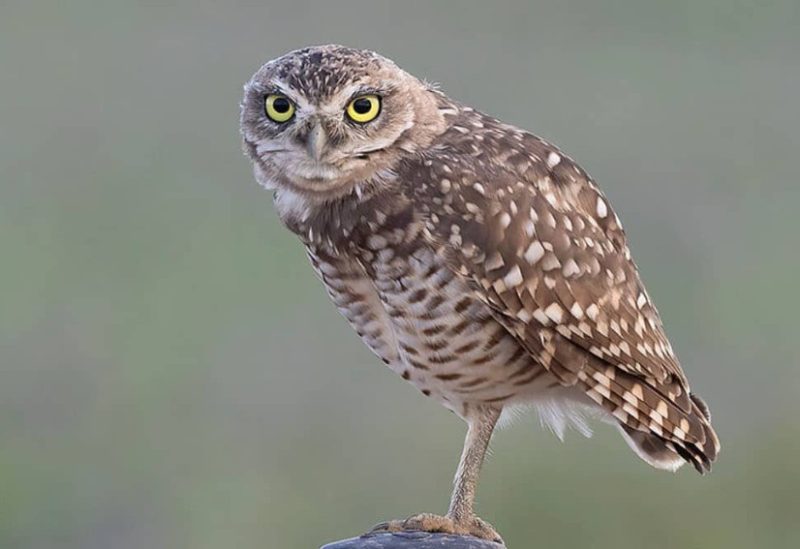
The Burrowing Owl is a small, long-legged owl that lives in open grasslands, deserts, and agricultural areas. It has brown mottled plumage with white spotting and bright yellow eyes. Unlike most owls, it often nests underground in burrows.
Burrowing Owls primarily hunt insects and small mammals, emerging from their burrows at dusk or dawn to forage. They rely on open visibility to detect predators and prey alike. This species is unique for its daytime activity and ground-dwelling habits.
In California, Burrowing Owls are commonly found in the Central Valley and coastal plains. They often use burrows dug by ground squirrels or other mammals, and conservation efforts sometimes provide artificial burrows for nesting.
Burrowing Owls lay 6–12 eggs, depending on food availability. Both parents care for the chicks, which leave the burrow at about 4–5 weeks old but continue to receive food until fully independent.
Northern Saw-whet Owl

The Northern Saw-whet Owl is one of the smallest owls in California, measuring only about 7 to 8 inches in length. It has a round head without ear tufts, large yellow eyes, and mottled brown plumage with white streaks on the head and underparts. Juveniles are darker with a distinctive rusty belly and a dark facial disk.
This owl primarily hunts small mammals, especially mice and voles. It is a nocturnal hunter that uses its sharp hearing and excellent night vision to detect prey in dense forests. Despite its size, it is a fierce predator, capable of capturing animals nearly as large as itself.
In California, Northern Saw-whet Owls inhabit coniferous and mixed woodlands, especially at higher elevations. They are often overlooked due to their secretive behavior and excellent camouflage. Birders usually detect them by their repetitive tooting calls at night.
Breeding occurs in tree cavities, often in abandoned woodpecker holes. The female lays 4–7 eggs, which she incubates while the male provides food. Chicks fledge after about a month but may remain dependent on their parents for several weeks.
Rough-legged Hawk

The Rough-legged Hawk is a large buteo that winters in California, recognizable by its feathered legs that extend to the toes. Adults have broad wings with dark patches at the wrist and a distinctive tail marked with a dark terminal band. Their plumage varies from light to dark morphs.
This hawk feeds primarily on small mammals such as voles, lemmings, and ground squirrels. It hunts by hovering in place over open fields, a behavior not commonly seen in other large hawks. Its keen eyesight allows it to detect movement even at great distances.
In California, Rough-legged Hawks are mostly seen in open grasslands and agricultural areas during the winter months. They breed far to the north in the Arctic tundra, migrating southward when food becomes scarce.
Nesting occurs on cliffs or in trees in their breeding grounds. Females lay 3–5 eggs, and both parents help raise the young. The chicks typically fledge after 5 to 6 weeks, preparing for their first migration.
Swainson’s Hawk
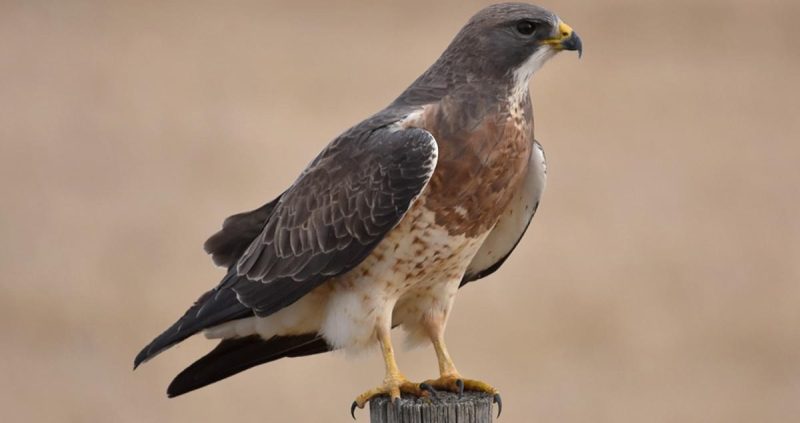
Swainson’s Hawk is a slender buteo known for its long, pointed wings and relatively small beak. Adults are generally brown above with a lighter underside and a distinctive dark chest band. Juveniles are paler, with variable streaking.
This species is an opportunistic feeder, hunting rodents, rabbits, and reptiles during the breeding season but shifting heavily to insects, especially grasshoppers, during migration. Large flocks of Swainson’s Hawks can be seen feeding together in agricultural fields.
In California, Swainson’s Hawks are found primarily in the Central Valley and open grasslands. They prefer nesting in isolated trees near farmlands, which provide both hunting grounds and perches.
During breeding, pairs build stick nests in tall trees. Females typically lay 2–3 eggs, and both parents care for the chicks. By late summer, these hawks prepare for their long migration to South America.
Broad-winged Hawk

The Broad-winged Hawk is a small, stocky raptor with short wings and a banded tail. Adults are dark brown above with pale underparts and a distinctive wide white band across the tail. Juveniles have streaked underparts and a less distinct tail pattern.
This hawk feeds on small mammals, amphibians, reptiles, and insects. It often hunts from a perch, swooping down on unsuspecting prey in the understory. During migration, it can be seen in large flocks called “kettles.”
In California, Broad-winged Hawks are rare migrants, most often seen in the fall. Their main range is in eastern North America, but some individuals appear in western states during migration.
Nesting usually takes place in deciduous forests. Females lay 2–3 eggs, incubating them for about a month. Chicks fledge in 5–6 weeks, learning to hunt before migration.
Short-eared Owl

The Short-eared Owl is a medium-sized owl with mottled brown plumage, pale underwings, and small, often hidden ear tufts. It has striking yellow eyes set in dark facial disks. Unlike many owls, it is often active during the day, especially at dawn and dusk.
This owl hunts primarily small mammals, such as voles and mice, by flying low over open fields and marshes. Its buoyant, moth-like flight makes it distinctive in appearance.
In California, Short-eared Owls inhabit grasslands, marshes, and agricultural areas, particularly in winter. They are nomadic, moving with rodent population cycles.
Short-eared Owls nest on the ground in grassy areas, scraping shallow depressions lined with vegetation. Females lay 4–7 eggs, which hatch after about a month. Chicks leave the nest at just two weeks old but remain dependent on their parents until they can fly.
Long-eared Owl
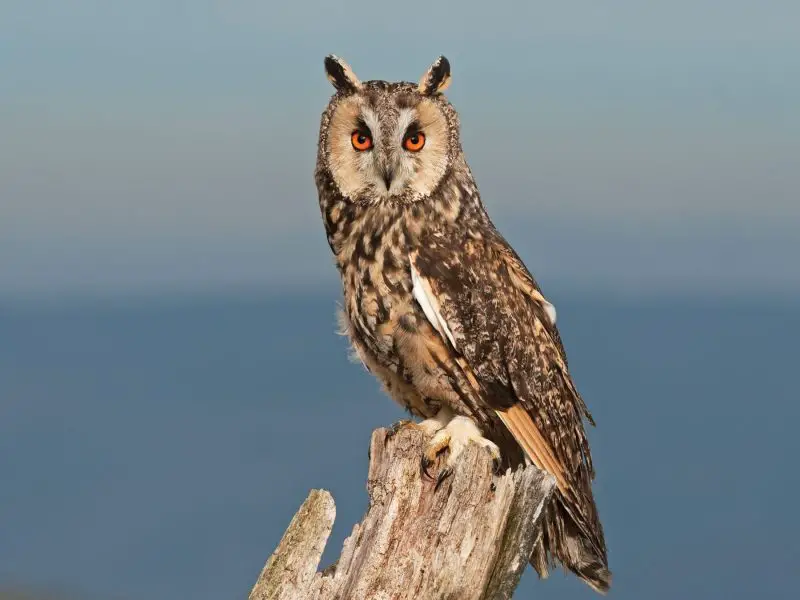
The Long-eared Owl is a medium-sized nocturnal raptor recognized by its tall, narrow ear tufts and orange facial disks. Its mottled brown plumage provides excellent camouflage against tree bark. Juveniles are downy with softer plumage, gradually developing the adult’s streaked appearance.
This owl feeds mainly on small mammals, particularly rodents, though it occasionally takes small birds. It hunts silently at night, flying low over fields and meadows to detect movement. Its long wings and buoyant flight help it patrol hunting grounds efficiently.
In California, Long-eared Owls inhabit riparian woodlands, shrublands, and coniferous forests. They roost communally in dense trees during winter, which can make them easier to locate.
Breeding occurs in spring, usually in abandoned stick nests of crows, hawks, or magpies. Females lay 4–6 eggs, incubating them while the male provides food. Young owls fledge in about three weeks but continue receiving care for several weeks more.
Northern Pygmy-Owl

The Northern Pygmy-Owl is one of the smallest owls in California, measuring only 6–7 inches long. Despite its size, it is a bold hunter with gray-brown plumage, spotted crown, and distinctive dark eye spots on the back of its head.
This owl preys on small birds, mammals, and large insects, often catching prey during daylight hours. Its habit of perching in the open on tree branches makes it easier to spot compared to more secretive owls.
In California, Northern Pygmy-Owls inhabit coniferous forests and mixed woodlands, especially at mid to high elevations in the Sierra Nevada and coastal ranges.
Breeding occurs in natural tree cavities or old woodpecker holes. Females lay 3–7 eggs, incubating them for nearly a month. Chicks fledge about a month after hatching, already capable of short flights and hunting practice.
Elf Owl
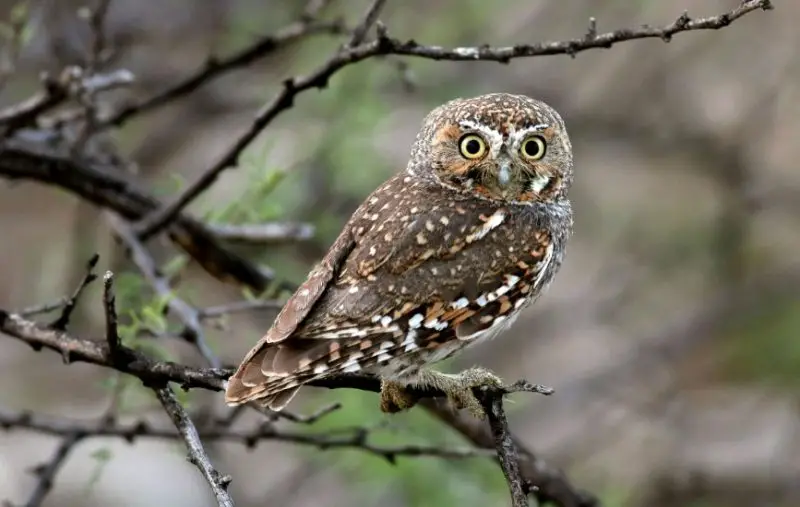
The Elf Owl is the world’s smallest owl, measuring only 5–6 inches in length. It has gray-brown plumage, pale underparts, and large yellow eyes. Its small size and insect-based diet set it apart from most other owls.
Elf Owls primarily hunt insects and small invertebrates, such as beetles, moths, and crickets. They are nocturnal, emerging after sunset to forage. Despite their small stature, they are agile hunters with quick, fluttering flight.
In California, Elf Owls are rare and restricted mostly to desert regions in the far south, including areas with saguaro cacti and mesquite woodlands. Their presence is seasonal, as many migrate south in winter.
Nesting occurs in tree cavities, often old woodpecker holes. Females lay 2–4 eggs, which hatch after about three weeks. The chicks fledge in less than a month, quickly becoming independent insect hunters.
Black Vulture
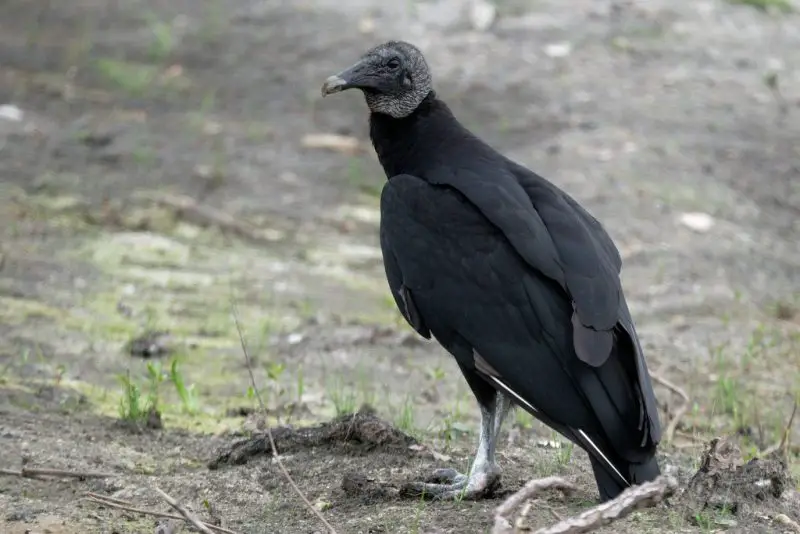
The Black Vulture is a large scavenging bird, identified by its black plumage, short tail, and featherless dark gray head. In flight, its broad wings show contrasting white patches near the tips.
Unlike most raptors, Black Vultures feed almost exclusively on carrion. They often rely on Turkey Vultures to locate carcasses with their keen sense of smell, then gather in groups to feed.
In California, Black Vultures are extremely rare, with only occasional sightings in the southern part of the state. Their core range is farther east and south in the United States, but strays sometimes appear.
Breeding occurs on the ground in caves, hollow trees, or abandoned buildings. Females typically lay 2 eggs, incubating them for about 40 days. Both parents feed the chicks through regurgitation until they fledge at around 10 weeks.
Turkey Vulture

The Turkey Vulture is one of the most common large raptors in California. It is recognized by its dark brown body, long two-toned wings, and featherless red head. Its teetering, V-shaped flight is a familiar sight over open landscapes.
This vulture feeds almost entirely on carrion, playing a vital role in the ecosystem by cleaning up dead animals. It uses its excellent sense of smell—the strongest of any bird—to locate food from great distances.
In California, Turkey Vultures inhabit a wide variety of environments, from coastal areas and deserts to forests and urban edges. They roost in groups on trees, cliffs, or buildings.
Nesting occurs in caves, hollow logs, or dense thickets. Females lay 1–3 eggs, which hatch after about five weeks. Chicks are fed by regurgitation and fledge at around 10 weeks of age.
California Condor
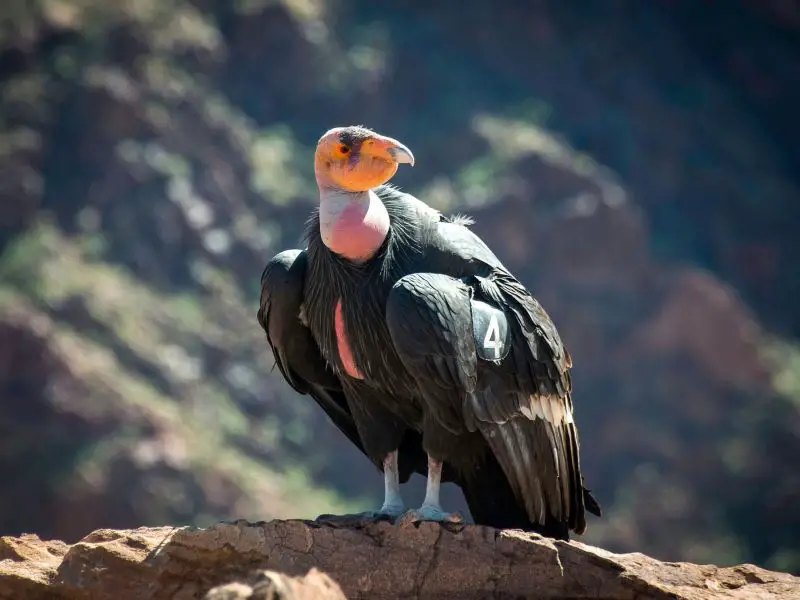
The California Condor is the largest flying bird in North America, with a wingspan reaching nearly 10 feet. Adults have mostly black plumage with large white patches under the wings, and a bald head that ranges in color from yellow to orange-red. Juveniles are darker overall with gray heads.
This species is primarily a scavenger, feeding on carrion such as deer, cattle, and marine mammals. With its powerful beak, it tears into carcasses and plays a vital ecological role as a cleaner of the environment. Unlike Turkey Vultures, it lacks a strong sense of smell and relies on sight to find food.
California Condors inhabit rugged mountains, canyons, and coastal cliffs. In California, they are found mainly in central and southern regions, including Pinnacles National Park and the coastal mountains near Big Sur. Their population is critically endangered but recovering due to intensive conservation programs.
Breeding pairs nest in caves or rocky crevices. Females usually lay a single egg every other year, and both parents share incubation and feeding duties. Young condors remain dependent on their parents for over a year before becoming fully independent.
Gyrfalcon
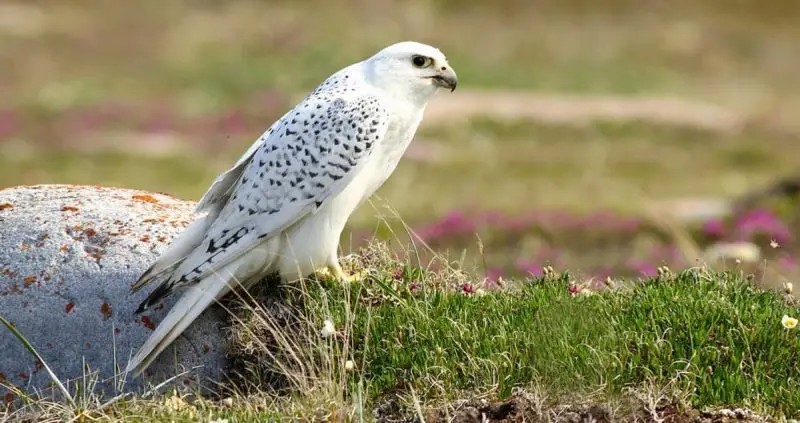
The Gyrfalcon is the largest falcon in the world and a rare visitor to California. It has broad wings, a powerful build, and variable plumage that can be white, gray, or dark brown. Its size and strong flight distinguish it from other falcons.
This falcon preys on medium-sized birds such as ducks, grouse, and seabirds, as well as small mammals. It is a formidable hunter, using rapid pursuit and surprise to capture prey in open landscapes.
In California, Gyrfalcons are very uncommon winter visitors, usually appearing along the northern coastlines or open inland habitats. Birders regard sightings as exceptional events.
Nesting occurs in the Arctic, where they lay 3–5 eggs in cliff ledges or old nests of other raptors. In California, they are non-breeding visitors, appearing only during migration or winter.
Northern Goshawk
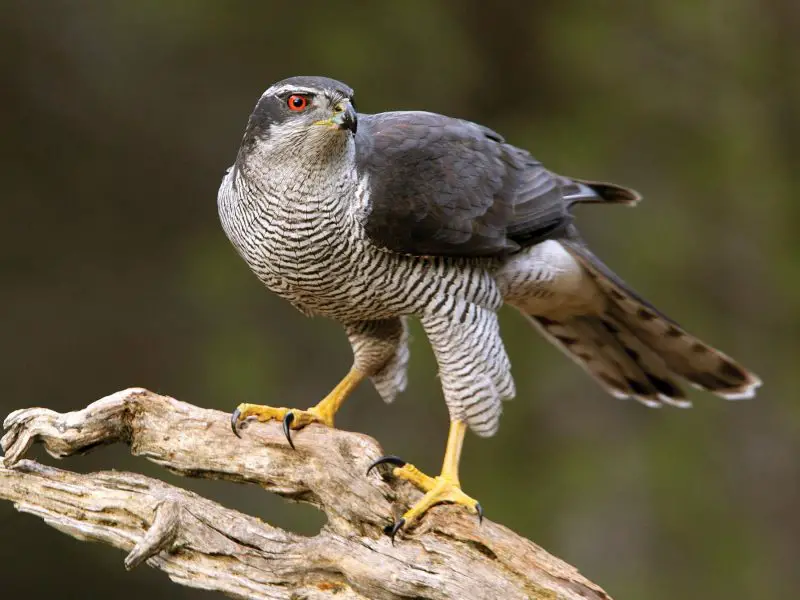
The Northern Goshawk is a powerful forest hawk, larger than Cooper’s and Sharp-shinned Hawks, with broad wings and a long tail. Adults have slate-gray upperparts, fine gray barring below, and striking red eyes. Juveniles are brown with streaked underparts.
This hawk preys on birds such as jays, woodpeckers, and grouse, as well as mammals like rabbits and squirrels. It hunts with stealth, flying swiftly through dense forests to ambush prey.
In California, Northern Goshawks are found mainly in mountainous forests of the Sierra Nevada and Cascade ranges. They prefer mature woodlands with dense canopy cover.
Nests are built high in tall conifer trees. Females lay 2–4 eggs, incubating them while the male supplies food. Chicks fledge after about five weeks but may stay near the nest for several more weeks.
Prairie Falcon
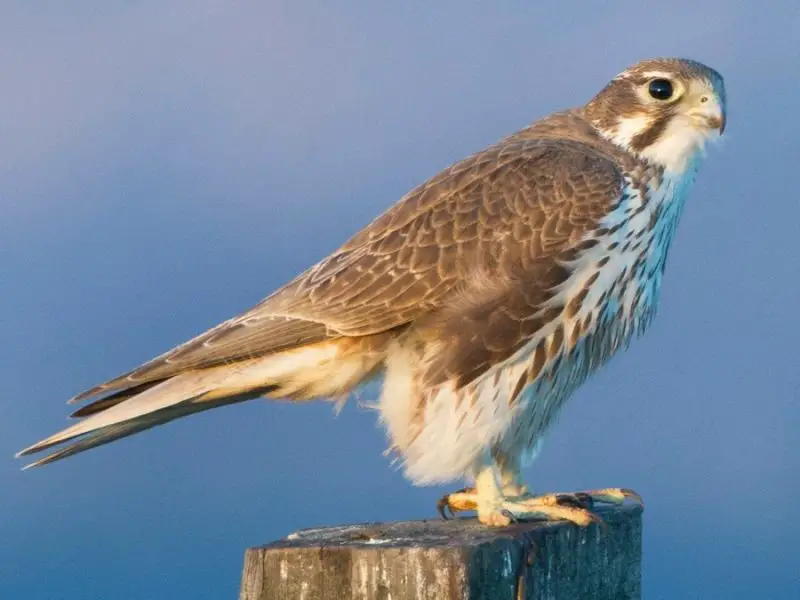
The Prairie Falcon is a medium-sized falcon native to the western United States. It is sandy brown above with pale underparts and dark axillary patches visible in flight. Its overall light coloration helps it blend into arid habitats.
This falcon feeds on birds such as larks, doves, and pigeons, as well as small mammals like ground squirrels. It hunts by soaring over open terrain before diving at prey with speed and precision.
In California, Prairie Falcons inhabit deserts, grasslands, and open scrublands. They are especially common in the Central Valley and arid eastern parts of the state.
Breeding occurs on cliff ledges, where females lay 3–5 eggs. Both parents share incubation and chick-rearing, with the young fledging at about six weeks.
Zone-tailed Hawk
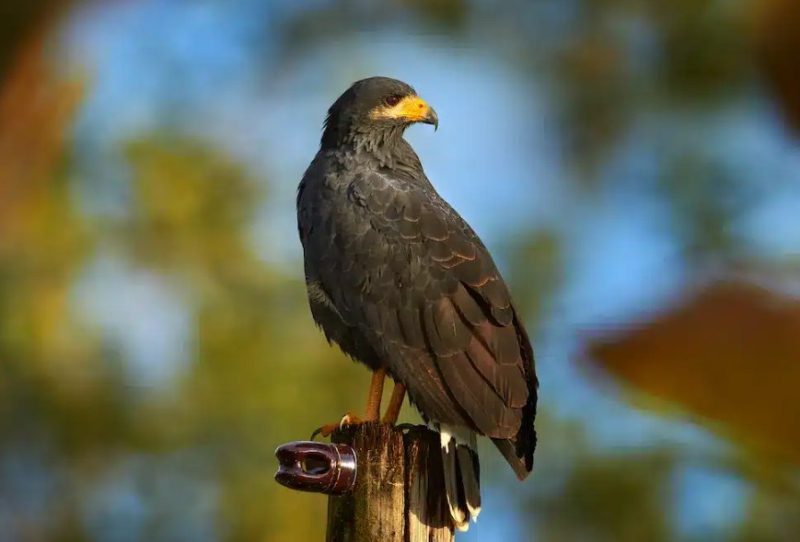
The Zone-tailed Hawk is a medium-sized raptor often mistaken for a Turkey Vulture due to its dark plumage and soaring flight style. It has blackish feathers with a white band across the tail, distinguishing it from vultures.
This hawk feeds on birds, reptiles, and small mammals, often using mimicry of vultures to approach prey unnoticed. It soars with wings held in a shallow V, blending in with scavengers before launching surprise attacks.
In California, Zone-tailed Hawks are rare visitors, primarily seen in the southern deserts and mountainous regions near the Mexican border. Their distribution within the state is limited and sporadic.
Nesting occurs in tall trees or cliffs, with 1–2 eggs laid per season. Both parents share the duties of incubation and feeding, and young hawks fledge after about six weeks.
Osprey

The Osprey is a large fish-eating raptor, easily recognized by its white head with a dark eye stripe, long wings, and dark brown upperparts. Its underparts are mostly white, and in flight it shows a distinctive crook in its wings. Juveniles resemble adults but have buff-colored feather edges.
This bird feeds almost exclusively on fish, diving feet-first into water to snatch prey with its sharp talons. Special adaptations such as reversible outer toes and barbed footpads make it an expert at grasping slippery fish.
In California, Ospreys are most common near rivers, lakes, and coastal areas. They can be found year-round in the northern part of the state and as migrants in other regions. Their presence indicates healthy aquatic ecosystems.
Ospreys nest in large stick structures built on tall trees, cliffs, or artificial platforms. Females typically lay 2–4 eggs, incubated for about five weeks. Both parents provide food for the chicks until they fledge after about two months.
Crested Caracara
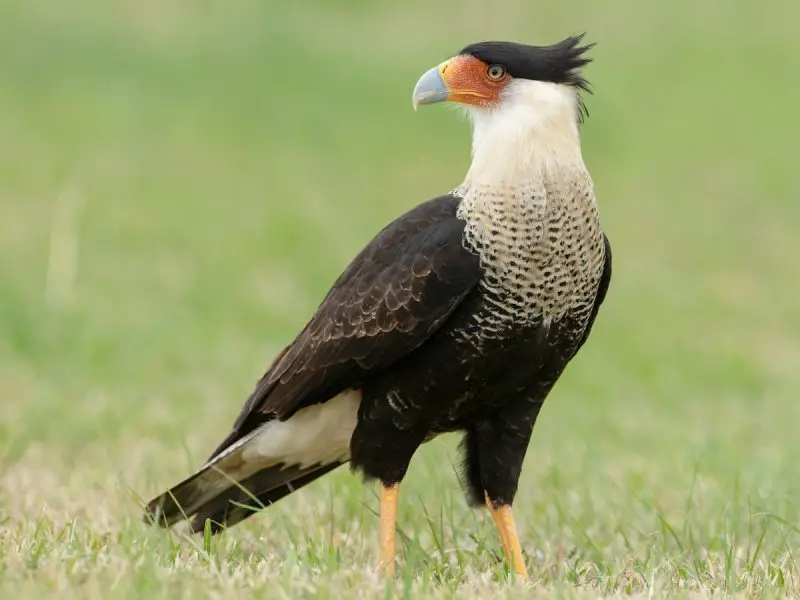
The Crested Caracara is an unusual bird of prey with long legs, a bare orange face, and a flat-topped head with a shaggy crest. It has black plumage with white patches on the neck and wings, giving it a striking appearance in flight.
Unlike most raptors, Caracaras are opportunistic feeders, consuming carrion, insects, reptiles, and small mammals. They often walk on the ground while foraging, a behavior uncommon among other birds of prey.
In California, Crested Caracaras are rare visitors, primarily seen in the southern deserts and occasionally along the coast. Most sightings are scattered and irregular, making them a special find for birders.
Breeding usually occurs in stick nests built in trees or cacti. Females lay 2–3 eggs, incubated for about a month. Both parents share feeding duties, and chicks fledge in around eight weeks.
White-tailed Kite
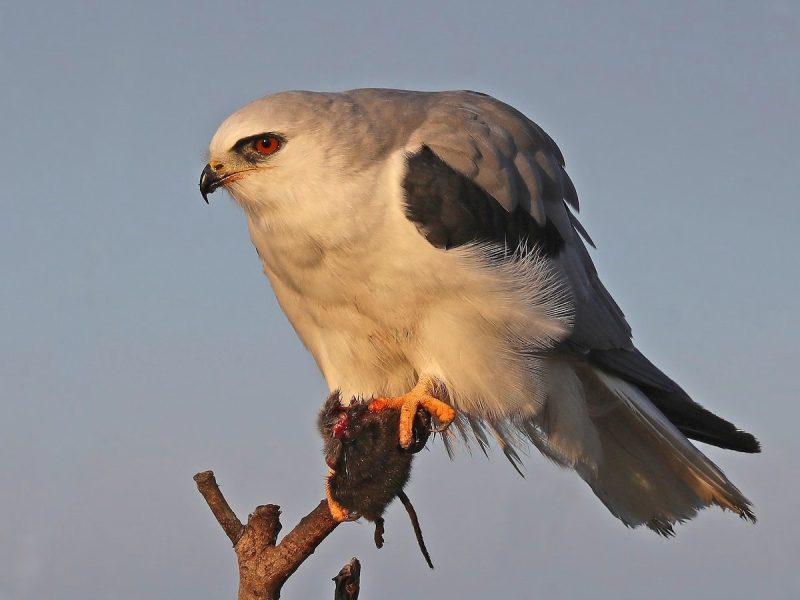
The White-tailed Kite is a graceful raptor with striking white plumage, gray wings, and black shoulder patches. It has a pure white tail and a hovering hunting style that makes it easy to identify.
This bird feeds mostly on small mammals such as voles and mice, hovering in place before diving down to capture prey. Its hovering behavior, similar to kestrels, sets it apart from other hawks.
In California, White-tailed Kites are found in open grasslands, farmlands, and wetlands, particularly in the Central Valley and coastal plains. They are year-round residents and can often be seen hunting over fields.
Nests are built in trees, often in colonies. Females lay 3–6 eggs, incubating them for about a month. Both parents provide food for the young until they fledge at around five weeks old.
FAQs About Birds of Prey in California
What is the most common bird of prey in California?
The Red-tailed Hawk is the most common raptor across California. It can be seen perched on poles, soaring over highways, or hunting in open fields. Its wide distribution and adaptability make it a familiar sight year-round.
Are there eagles in California?
Yes, California is home to both Bald Eagles and Golden Eagles. Bald Eagles are often seen near lakes and rivers, while Golden Eagles prefer open mountains and grasslands. Conservation programs have helped both species remain stable in the state.
What is the largest bird of prey in California?
The California Condor holds the title as the largest raptor, with a wingspan of nearly 10 feet. Once critically endangered, it has made a remarkable comeback through intensive conservation efforts in central and southern California.
Can you see owls during the day in California?
Most owls are nocturnal, but some species like the Burrowing Owl can be active during daylight hours. Birders may also spot Great Horned Owls or Barn Owls roosting in trees or barns during the day.
Where is the best place to see birds of prey in California?
Excellent locations include the Sierra Nevada, the Central Valley, and coastal regions like Big Sur and Point Reyes. Wildlife refuges and open grasslands also provide prime habitats for spotting hawks, owls, and falcons.



